Rethinking Self-Attention: Towards Interpret ability in Neural Parsing
重新思考自注意力机制:神经网络解析中的可解释性
Abstract
摘要
Attention mechanisms have improved the performance of NLP tasks while allowing models to remain explain able. Self-attention is cur- rently widely used, however interpret ability is difficult due to the numerous attention distributions. Recent work has shown that model representations can benefit from label-specific information, while facilitating interpretation of predictions. We introduce the Label Attention Layer: a new form of self-attention where attention heads represent labels. We test our novel layer by running constituency and dependency parsing experiments and show our new model obtains new state-of-the-art results for both tasks on both the Penn Treebank (PTB) and Chinese Treebank. Additionally, our model requires fewer self-attention layers compared to existing work. Finally, we find that the Label Attention heads learn relations between syntactic categories and show pathways to analyze errors.
注意力机制在提升自然语言处理(NLP)任务性能的同时,保持了模型的可解释性。自注意力(self-attention)机制当前被广泛使用,但由于存在大量注意力分布,其可解释性仍然面临挑战。近期研究表明,融入标签特定信息能提升模型表征能力,同时有助于预测结果的可解释性。我们提出标签注意力层(Label Attention Layer):一种新型自注意力机制,其注意力头对应具体标签。通过进行选区解析和依存解析实验验证,我们的新模型在宾州树库(PTB)和中文树库上均取得了两项任务的最先进成果。此外,与现有工作相比,该模型所需的自注意力层数更少。最后,我们发现标签注意力头能够学习句法类别间的关系,并提供了分析错误的途径。
1 Introduction
1 引言
Attention mechanisms (Bahdanau et al., 2014; Luong et al., 2015) provide arguably explain able attention distributions that can help to interpret predic- tions. For example, for their machine translation predictions, Bahdanau et al. (2014) show a heat map of attention weights from source language words to target language words. Similarly, in transformer architectures (Vaswani et al., 2017), a selfattention head produces attention distributions from the input words to the same input words, as shown in the second row on the right side of Figure 1. However, self-attention mechanisms have multiple heads, making the combined outputs difficult to interpret.
注意力机制 (Bahdanau et al., 2014; Luong et al., 2015) 提供了可解释的注意力分布,有助于解释预测结果。例如,Bahdanau et al. (2014) 在其机器翻译预测中展示了从源语言单词到目标语言单词的注意力权重热力图。类似地,在 Transformer 架构 (Vaswani et al., 2017) 中,自注意力头会生成从输入单词到同一输入单词的注意力分布,如图 1 右侧第二行所示。然而,自注意力机制具有多头结构,使得组合输出难以解释。
Recent work in multi-label text classification (Xiao et al., 2019) and sequence labeling (Cui and Zhang, 2019) shows the efficiency and interpret a bility of label-specific representations. We introduce the Label Attention Layer: a modified version of self-attention, where each classification label corresponds to one or more attention heads. We project the output at the attention head level, rather than after aggregating all outputs, to preserve the source of head-specific information, thus allowing us to match labels to heads.
多标签文本分类 (Xiao et al., 2019) 和序列标注 (Cui and Zhang, 2019) 的最新研究表明,标签特定表示 (label-specific representations) 具有高效性和可解释性。我们提出了标签注意力层 (Label Attention Layer):一种改进的自注意力机制,其中每个分类标签对应一个或多个注意力头。我们在注意力头级别进行输出投影,而非聚合所有输出后再投影,以保留特定头部信息的来源,从而实现标签与注意力头的匹配。
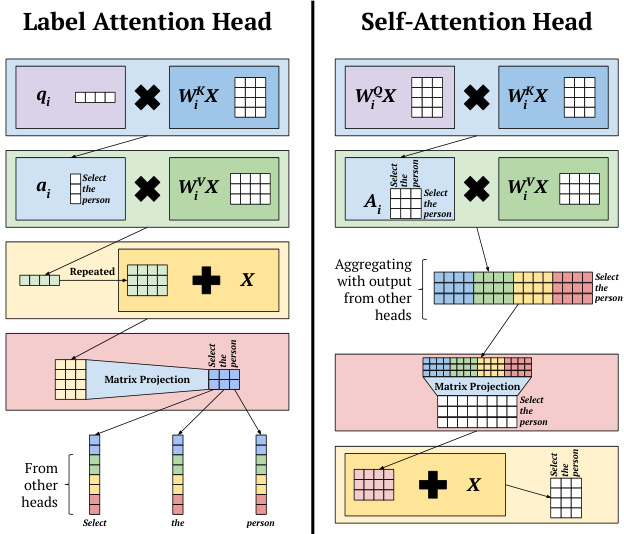
Figure 1: Comparison of the attention head architectures of our proposed Label Attention Layer and a SelfAttention Layer (Vaswani et al., 2017). The matrix $\mathbf{X}$ represents the input sentence “Select the person”.
图 1: 我们提出的标签注意力层 (Label Attention Layer) 与自注意力层 (SelfAttention Layer) (Vaswani et al., 2017) 的注意力头架构对比。矩阵 $\mathbf{X}$ 表示输入句子"Select the person"。
To test our proposed Label Attention Layer, we build upon the parser of Zhou and Zhao (2019) and establish a new state of the art for both constituency and dependency parsing, in both English and Chinese. We also release our pre-trained parsers, as well as our code to encourage experiments with the Label Attention Layer 1.
为验证我们提出的标签注意力层(Label Attention Layer),我们在Zhou和Zhao(2019)的解析器基础上进行改进,在英语和汉语的选区解析与依存解析任务中均取得了新的最优性能。同时开源了预训练解析器及代码,以促进标签注意力层的实验研究[1]。
2 Label Attention Layer
2 标签注意力层
The self-attention mechanism of Vaswani et al. (2017) propagates information between the words of a sentence. Each resulting word representation
Vaswani等人(2017)提出的自注意力机制实现了句子中词语间的信息传递。每个生成的词语表征
Example Input
示例输入
The Label Attention Layer takes word vectors as input (red-contour matrix). In the example sentence, start and end symbols are omitted.
标签注意力层以词向量作为输入(红色轮廓矩阵)。示例句子中省略了起始和结束符号。
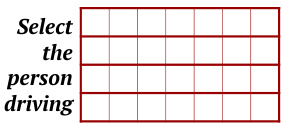

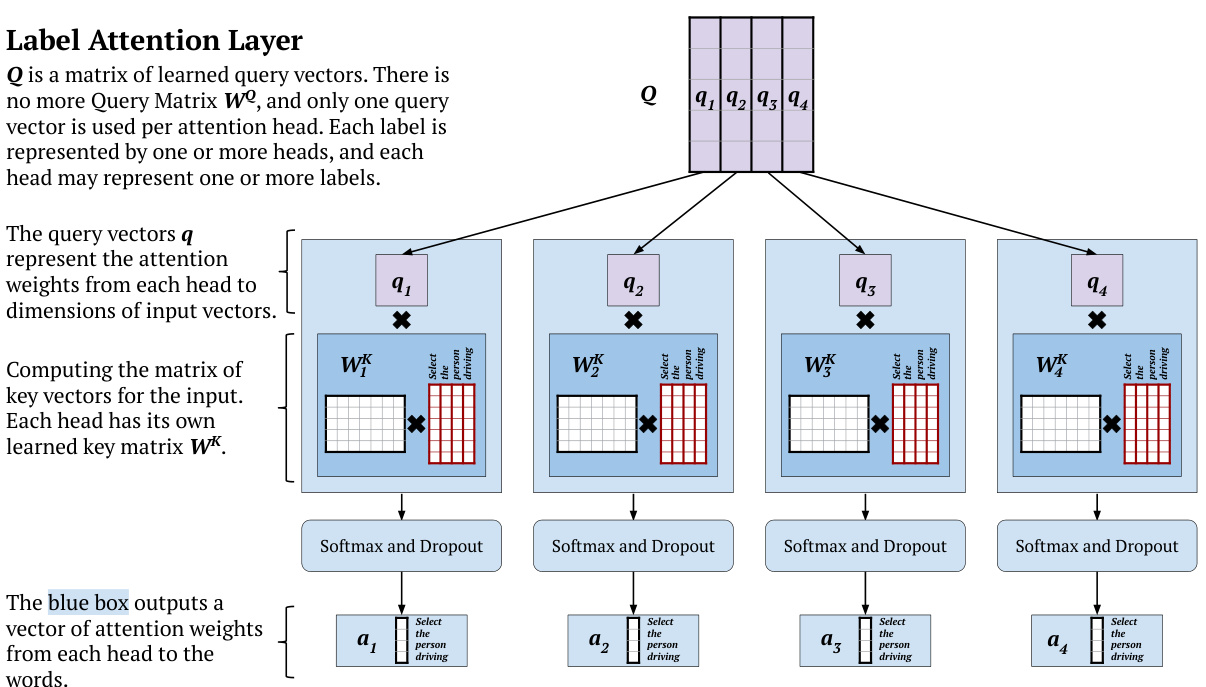
Figure 2: The architecture of the top of our proposed Label Attention Layer. In this figure, the example input sentence is “Select the person driving”.
图 2: 我们提出的标签注意力层 (Label Attention Layer) 顶部架构示意图。图中示例输入句子为"Select the person driving"。
contains its own attention-weighted view of the sentence. We hypothesize that a word representation can be enhanced by including each label’s attention-weighted view of the sentence, on top of the information obtained from self-attention.
包含该句子自身的注意力加权视图。我们假设,在自注意力(self-attention)获得的信息基础上,通过纳入每个标签对句子的注意力加权视图,可以增强词表征。
The Label Attention Layer (LAL) is a novel, modified form of self-attention, where only one query vector is needed per attention head. Each classification label is represented by one or more attention heads, and this allows the model to learn label-specific views of the input sentence. Figure 1 shows a high-level comparison between our Label Attention Layer and self-attention.
标签注意力层 (Label Attention Layer, LAL) 是一种改进的自注意力机制变体,其每个注意力头仅需一个查询向量。每个分类标签由一个或多个注意力头表示,这使得模型能够学习输入句子中与特定标签相关的视图。图 1: 展示了标签注意力层与自注意力机制的高层对比。
We explain the architecture and intuition behind our proposed Label Attention Layer through the example application of parsing.
我们通过解析的示例应用来解释所提出的标签注意力层 (Label Attention Layer) 的架构和设计思路。
Figure 2 shows one of the main differences between our Label Attention mechanism and selfattention: the absence of the Query matrix $\mathbf{W}^{\mathbf{Q}}$ Instead, we have a learned matrix $\mathbf{Q}$ of query vectors representing each head. More formally, for the attention head $i$ and an input matrix $\mathbf{X}$ of word vectors, we compute the corresponding attention weights vector $\mathbf{a}_{i}$ as follows:
图 2: 展示了我们的标签注意力机制与自注意力机制的主要区别之一:移除了查询矩阵 $\mathbf{W}^{\mathbf{Q}}$,取而代之的是表示每个注意力头的可学习查询向量矩阵 $\mathbf{Q}$。更正式地说,对于注意力头 $i$ 和词向量输入矩阵 $\mathbf{X}$,我们按如下方式计算对应的注意力权重向量 $\mathbf{a}_{i}$:
$$
\mathbf{a}{i}=\mathrm{softmax}\left(\frac{\mathbf{q}{i}*\mathbf{K}_{i}}{\sqrt{d}}\right)
$$
$$
\mathbf{a}{i}=\mathrm{softmax}\left(\frac{\mathbf{q}{i}*\mathbf{K}_{i}}{\sqrt{d}}\right)
$$
where $d$ is the dimension of query and key vectors, $\mathbf{K}{i}$ is the matrix of key vectors. Given a learned head-specific key matrix $\mathbf{W}{i}^{K}$ , we compute $\mathbf{K}_{i}$ as:
其中 $d$ 是查询(query)和键(key)向量的维度,$\mathbf{K}{i}$ 是键向量的矩阵。给定一个学习到的头特定键矩阵 $\mathbf{W}{i}^{K}$,我们计算 $\mathbf{K}_{i}$ 为:
$$
\mathbf{K}{i}=\mathbf{W}_{i}^{K}\mathbf{X}
$$
$$
\mathbf{K}{i}=\mathbf{W}_{i}^{K}\mathbf{X}
$$
Each attention head in our Label Attention layer has an attention vector, instead of an attention matrix as in self-attention. Consequently, we do not obtain a matrix of vectors, but a single vector that contains head-specific context information. This context vector corresponds to the green vector in Figure 3. We compute the context vector $\mathbf{c}_{i}$ of head $i$ as follows:
我们的标签注意力层中,每个注意力头都有一个注意力向量,而非自注意力中的注意力矩阵。因此,我们不会得到一个向量矩阵,而是一个包含特定头上下文信息的单一向量。该上下文向量对应图3中的绿色向量。我们按如下方式计算头$i$的上下文向量$\mathbf{c}_{i}$:
$$
\mathbf{c}{i}=\mathbf{a}{i}*\mathbf{V}_{i}
$$
$$
\mathbf{c}{i}=\mathbf{a}{i}*\mathbf{V}_{i}
$$
where $\mathbf{a}{i}$ is the vector of attention weights in Equation 1, and $\mathbf{V}{i}$ is the matrix of value vectors. Given a learned head-specific value matrix $\mathbf{W}{i}^{V}$ , we compute $\mathbf{V}_{i}$ as:
其中 $\mathbf{a}{i}$ 是公式1中的注意力权重向量,$\mathbf{V}{i}$ 是值向量矩阵。给定学习到的特定头值矩阵 $\mathbf{W}{i}^{V}$,我们计算 $\mathbf{V}_{i}$ 如下:
$$
\mathbf{V}{i}=\mathbf{W}_{i}^{V}\mathbf{X}
$$
$$
\mathbf{V}{i}=\mathbf{W}_{i}^{V}\mathbf{X}
$$
The context vector gets added to each individual input vector – making for one residual connection per head, rather one for all heads, as in the yellow box in Figure 3. We project the resulting matrix of word vectors to a lower dimension before normalizing. We then distribute the vectors computed by each label attention head, as shown in Figure 4.
上下文向量会与每个单独的输入向量相加——为每个注意力头形成一个残差连接,而非像图3黄色框所示那样为所有头共用一个。在归一化之前,我们会将生成的词向量矩阵投影到更低维度。随后如图4所示,分配由各标签注意力头计算得到的向量。
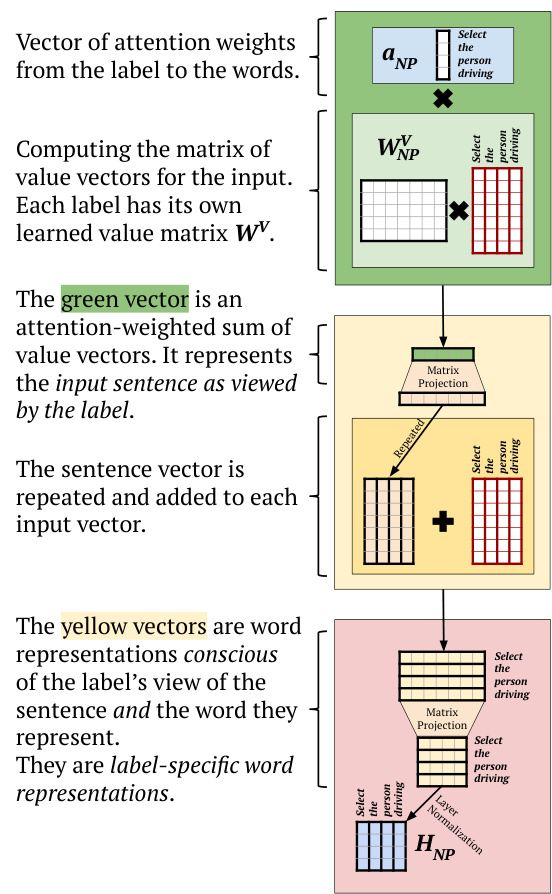
Figure 3: The Value vector computations in our proposed Label Attention Layer.
图 3: 我们提出的标签注意力层中的值向量计算。
We chose to assign as many attention heads to the Label Attention Layer as there are classification labels. As parsing labels (syntactic categories) are related, we did not apply an orthogonality loss to force the heads to learn separate information. We therefore expect an overlap when we match labels to heads. The values from each head are identifiable within the final word representation, as shown in the color-coded vectors in Figure 4.
我们选择为标签注意力层 (Label Attention Layer) 分配与分类标签数量相同的注意力头。由于解析标签 (句法类别) 相关联,我们没有应用正交损失来强制各头学习不同信息。因此,在将标签与头匹配时,我们预期会出现重叠。如图 4 中颜色编码的向量所示,每个头的值在最终词表示中是可识别的。
The activation functions of the position-wise feed-forward layer make it difficult to follow the path of the contributions. Therefore we can remove the position-wise feed-forward layer, and compute the contributions from each label. We provide an example in Figure 6, where the contributions are computed using normalization and averaging. In this case, we are computing the contributions of each head to the span vector. The span representation for “the person” is computed following the method of Gaddy et al. (2018) and Kitaev and Klein (2018). However, forward and backward representations are not formed by splitting the entire word vector at the middle, but rather by splitting each head-specific word vector at the middle.
逐位置前馈层的激活函数使得贡献路径难以追踪。因此我们可以移除逐位置前馈层,转而计算每个标签的贡献值。我们在图6中提供了一个示例,其中贡献值通过归一化和平均化计算得出。此案例中,我们计算的是每个注意力头对span向量的贡献。"the person"的span表征采用Gaddy等人(2018)与Kitaev和Klein(2018)的方法计算。但前向与后向表征并非通过将整个词向量从中部切分形成,而是通过将每个注意力头专属的词向量从中部切分获得。
In the example in Figure 6, we show averaging as one way of computing contributions, other functions, such as softmax, can be used. Another way of interpreting predictions is to look at the head-toword attention distributions, which are the output vectors in the computation in Figure 2.
在图6的示例中,我们展示了平均值计算贡献度的一种方式,也可以使用其他函数(如softmax)。另一种解释预测的方法是观察头词注意力分布,即图2计算过程中的输出向量。
3 Syntactic Parsing Model
3 句法解析模型
3.1 Encoder
3.1 编码器
Our parser is an encoder-decoder model. The encoder has self-attention layers (Vaswani et al., 2017), preceding the Label Attention Layer. We follow the attention partition of Kitaev and Klein (2018), who show that separating content embeddings from position ones improves performance.
我们的解析器采用编码器-解码器架构。编码器包含自注意力层 (Vaswani et al., 2017) 和前置的标签注意力层。我们遵循 Kitaev 和 Klein (2018) 提出的注意力分区方法,该方法证明将内容嵌入与位置嵌入分离能提升模型性能。
Sentences are pre-processed following Zhou and Zhao (2019). Trees are represented using a simplified Head-driven Phrase Structure Grammar (HPSG) (Pollard and Sag, 1994). In Zhou and Zhao (2019), two kinds of span representations are proposed: the division span and the joint span. We choose the joint span representation as it is the best-performing one in their experiments. Figure 5 shows how the example sentence in Figure 2 is represented.
句子预处理遵循Zhou和Zhao (2019)的方法。树结构采用简化的中心词驱动短语结构语法 (HPSG) (Pollard and Sag, 1994) 表示。Zhou和Zhao (2019) 提出了两种跨度表示:分割跨度和联合跨度。我们选择联合跨度表示,因为这是他们实验中表现最佳的方式。图5展示了图2中例句的表示方法。
The token representations for our model are a concatenation of content and position embeddings. The content embeddings are a sum of word and part-of-speech embeddings.
我们模型的Token表示是内容嵌入和位置嵌入的拼接。内容嵌入是词嵌入和词性嵌入的总和。
3.2 Constituency Parsing
3.2 成分句法分析
For constituency parsing, span representations follow the definition of Gaddy et al. (2018) and Kitaev and Klein (2018). For a span starting at the $i$ -th word and ending at the $j$ -th word, the corresponding span vector $s_{i j}$ is computed as:
对于成分句法分析,span表示遵循Gaddy等人(2018) 和Kitaev与Klein(2018) 的定义。对于一个起始于第$i$个单词、结束于第$j$个单词的span,其对应的span向量$s_{ij}$计算方式为:
$$
\mathbf{s_{ij}}=\left[{\overrightarrow{\mathbf{h_{j}}}}-{\overrightarrow{\mathbf{h_{i-1}}}};{\overleftarrow{\mathbf{h_{j+1}}}}-{\overleftarrow{\mathbf{h_{i}}}}\right]
$$
$$
\mathbf{s_{ij}}=\left[{\overrightarrow{\mathbf{h_{j}}}}-{\overrightarrow{\mathbf{h_{i-1}}}};{\overleftarrow{\mathbf{h_{j+1}}}}-{\overleftarrow{\mathbf{h_{i}}}}\right]
$$
where $\overleftarrow{\mathbf{h}{\mathbf{i}}}$ and $\overrightarrow{\mathbf{h}_{\mathbf{i}}}$ are respectively the backward and forward representation of the $i$ -th word obtained by splitting its representation in half. An example of a span representation is shown in the middle of Figure 6.
其中 $\overleftarrow{\mathbf{h}{\mathbf{i}}}$ 和 $\overrightarrow{\mathbf{h}_{\mathbf{i}}}$ 分别是通过将第 $i$ 个词的表示分成两半得到的后向和前向表示。图 6 中间展示了一个跨度表示的示例。
The score vector for the span is obtained by applying a one-layer feed-forward layer:
该跨度的得分向量通过应用单层前馈层获得:
$$
\mathbf{S}(i,j)=\mathbf{W_{2}R e L U}(\mathrm{LN}(\mathbf{W_{1}s_{i j}}+\mathbf{b_{1}}))+\mathbf{b_{2}}
$$
$$
\mathbf{S}(i,j)=\mathbf{W_{2}R e L U}(\mathrm{LN}(\mathbf{W_{1}s_{i j}}+\mathbf{b_{1}}))+\mathbf{b_{2}}
$$
The Position-wise Feed-Forward Layer may optionally be removed.
位置前馈层 (Position-wise Feed-Forward Layer) 可以选择性移除。
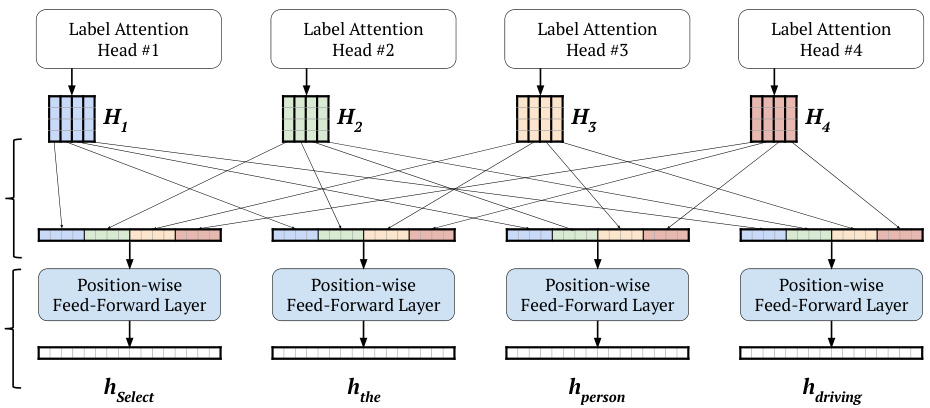
Figure 4: Redistribution of the head-specific word representations to form word vectors by concatenation. We use different colors for each label attention head. The colors show where the head outputs go in the word representations. We do not use colors for the vectors resulting from the position-wise feed-forward layer, as the head-specific information moved.
图 4: 通过拼接重新分配头部特定词表征以形成词向量。我们为每个标签注意力头使用不同颜色,颜色表明头部输出在词表征中的去向。由于位置前馈层移动了头部特定信息,因此未对由此产生的向量着色。
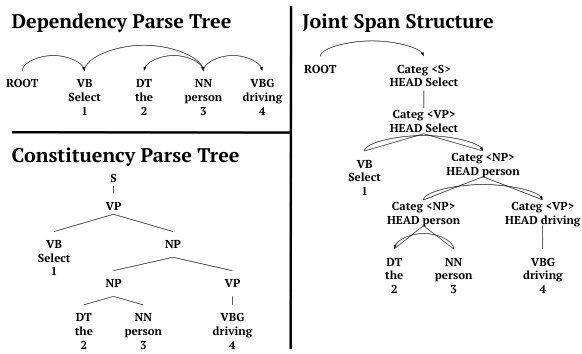
Figure 5: Parsing representations of the example sentence in Figure 2.
图 5: 图 2 中例句的解析表示。
where LN is Layer Normalization, and $\mathbf{W_{1}},\mathbf{W_{2}}$ , $\mathbf{b_{1}}$ and $\mathbf{b_{2}}$ are learned parameters. For the $l$ -th syntactic category, the corresponding score $s(i,j,l)$ is then the $l$ -th value in the $\mathbf{S}(i,j)$ vector.
其中 LN 表示层归一化 (Layer Normalization),$\mathbf{W_{1}},\mathbf{W_{2}}$、$\mathbf{b_{1}}$ 和 $\mathbf{b_{2}}$ 为可学习参数。对于第 $l$ 个句法类别,其对应得分 $s(i,j,l)$ 即为向量 $\mathbf{S}(i,j)$ 中的第 $l$ 个值。
Consequently, the score of a constituency parse tree $T$ is the sum of all of the scores of its spans and their syntactic categories:
因此,选区解析树 $T$ 的分数是其所有跨度和句法类别分数的总和:
$$
s(T)=\sum_{(i,j,l)\in T}s(i,j,l)
$$
$$
s(T)=\sum_{(i,j,l)\in T}s(i,j,l)
$$
We then use a CKY-style algorithm (Stern et al., 2017; Gaddy et al., 2018) to find the highest scoring tree $\hat{T}$ . The model is trained to find the correct parse tree $T^{*}$ , such that for all trees $T$ , the following margin constraint is satisfied:
我们随后采用CKY风格算法 (Stern et al., 2017; Gaddy et al., 2018) 来寻找最高分树 $\hat{T}$ 。该模型被训练用于寻找正确解析树 $T^{*}$ ,使得对于所有树 $T$ ,满足以下边界约束条件:
$$
s(T^{})\geq s(T)+\Delta(T,T^{*})
$$
$$
s(T^{})\geq s(T)+\Delta(T,T^{*})
$$
where $\Delta$ is the Hamming loss on labeled spans. The corresponding loss function is the hinge loss:
其中 $\Delta$ 是标注跨度的汉明损失 (Hamming loss)。对应的损失函数是合页损失 (hinge loss):
$$
L_{c}=\operatorname*{max}\left(0,\operatorname*{max}_{T}[s(T)+\Delta(T,T^{})]-s(T^{*})\right)
$$
$$
L_{c}=\operatorname*{max}\left(0,\operatorname*{max}_{T}[s(T)+\Delta(T,T^{})]-s(T^{*})\right)
$$
3.3 Dependency Parsing
3.3 依存句法分析
We use the biaffine attention mechanism (Dozat and Manning, 2016) to compute a probability distribution for the dependency head of each word. The child-parent score $\alpha_{i j}$ for the $j$ -th word to be the head of the $i$ -th word is:
我们使用双仿射注意力机制 (biaffine attention mechanism) [20] 来计算每个词语依存头的概率分布。第$j$个词作为第$i$个词依存头的子父得分$\alpha_{ij}$为:
$$
\alpha_{i j}=\mathbf{h_{i}^{(d)}}^{T}\mathbf{W}\mathbf{h_{j}^{(h)}}+\mathbf{U}^{T}\mathbf{h_{i}^{(d)}}+\mathbf{V}^{T}\mathbf{h_{j}^{(h)}}+b
$$
$$
\alpha_{i j}=\mathbf{h_{i}^{(d)}}^{T}\mathbf{W}\mathbf{h_{j}^{(h)}}+\mathbf{U}^{T}\mathbf{h_{i}^{(d)}}+\mathbf{V}^{T}\mathbf{h_{j}^{(h)}}+b
$$
where $\mathbf{h_{i}^{(d)}}$ is the dependent representation of the $i$ -th word obtained by putting its representation $\mathbf{h}{\mathbf{i}}$ through a one-layer perceptron. Likewise, $\mathbf{h_{j}^{(h)}}$ is the head representation of the $j$ -th word obtained by putting its representation $\mathbf{h}_{\mathbf{j}}$ through a separate one-layer perceptron. The matrices W, U and $\mathbf{V}$ are learned parameters.
其中 $\mathbf{h_{i}^{(d)}}$ 是通过将第 $i$ 个单词的表示 $\mathbf{h}{\mathbf{i}}$ 输入单层感知机得到的依赖表示。类似地,$\mathbf{h_{j}^{(h)}}$ 是通过将第 $j$ 个单词的表示 $\mathbf{h}_{\mathbf{j}}$ 输入另一个单层感知机得到的主干表示。矩阵 W、U 和 $\mathbf{V}$ 是待学习的参数。
The model trains on dependency parsing by minimizing the negative likelihood of the correct dependency tree. The loss function is cross-entropy:
模型通过最小化正确依存树的负对数似然来进行依存解析训练。损失函数为交叉熵:
$$
L_{d}=-\mathrm{log}\left(P\left(h_{i}|d_{i}\right)P\left(l_{i}|d_{i},h_{i}\right)\right)
$$
$$
L_{d}=-\mathrm{log}\left(P\left(h_{i}|d_{i}\right)P\left(l_{i}|d_{i},h_{i}\right)\right)
$$
where $h_{i}$ is the correct head for dependent $d_{i}$ , $P\left(h_{i}|d_{i}\right)$ is the probability that $h_{i}$ is the head of $d_{i}$ , and $P\left({{l}{i}}|{{d}{i}},{{h}{i}}\right)$ is the probability of the correct dependency label $l_{i}$ for the child-parent pair $(d_{i},h_{i})$ .
其中 $h_{i}$ 是依存词 $d_{i}$ 的正确中心词,$P\left(h_{i}|d_{i}\right)$ 表示 $h_{i}$ 作为 $d_{i}$ 中心词的概率,$P\left({{l}{i}}|{{d}{i}},{{h}{i}}\right)$ 表示子-父对 $(d_{i},h_{i})$ 获得正确依存标签 $l_{i}$ 的概率。
Computing Head Contributions
计算头部贡献
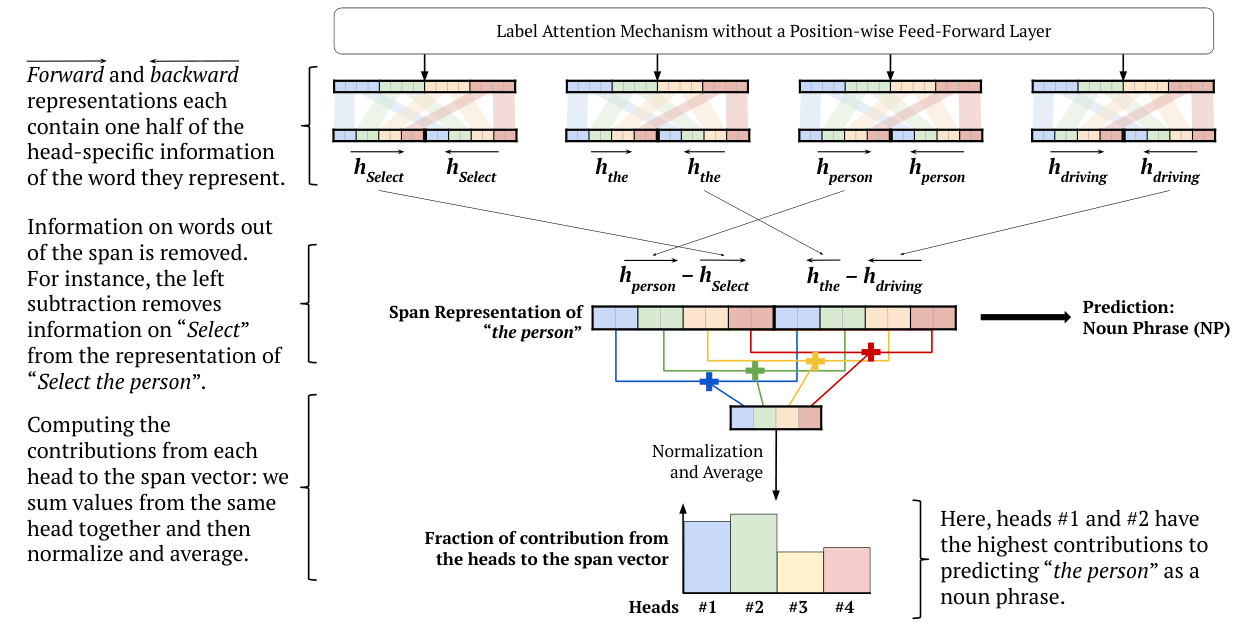
Figure 6: If we remove the position-wise feed-forward layer, we can compute the contributions from each label attention head to the span representation, and thus interpret head contributions. This illustrative example follows the label color scheme in Figure 4.
图 6: 如果移除位置前馈层,我们可以计算每个标签注意力头对跨度表示的贡献,从而解释头的贡献。此示例遵循图4中的标签配色方案。
3.4 Decoder
3.4 解码器
The model jointly trains on constituency and dependency parsing by minimizing the sum of the constituency and dependency losses:
该模型通过最小化成分句法分析和依存句法分析的损失之和进行联合训练:
$$
L=L_{c}+L_{d}
$$
$$
L=L_{c}+L_{d}
$$
The decoder is a CKY-style (Kasami, 1966; Younger, 1967; Cocke, 1969; Stern et al., 2017) algorithm, modified by Zhou and Zhao (2019) to include dependency scores.
解码器采用CKY风格算法 (Kasami, 1966; Younger, 1967; Cocke, 1969; Stern et al., 2017),并由Zhou和Zhao (2019) 改进以包含依存分数。
4 Experiments
4 实验
We evaluate our model on the English Penn Treebank (PTB) (Marcus et al., 1993) and on the Chinese Treebank (CTB) (Xue et al., 2005). We use the Stanford tagger (Toutanova et al., 2003) to pre- dict part-of-speech tags and follow standard data splits.
我们在英文宾州树库 (PTB) (Marcus等人, 1993) 和中文树库 (CTB) (Xue等人, 2005) 上评估模型。使用斯坦福标注器 (Toutanova等人, 2003) 预测词性标签,并遵循标准数据划分。
Following standard practice, we use the EVALB algorithm (Sekine and Collins, 1997) for constituency parsing, and report results without punctuation for dependency parsing.
按照标准做法,我们使用EVALB算法 (Sekine and Collins, 1997) 进行成分句法分析,并报告不带标点的依存句法分析结果。
4.1Setup
4.1 设置
In our English-language experiments, the Label Attention Layer has 112 heads: one per syntactic category. However, this is an experimental choice, as the model is not designed to have a one-on-one corresponden ce between attention heads and syntactic categories. The Chinese Treebank is a smaller dataset, and therefore we use 64 heads in Chineselanguage experiments, even though the number of Chinese syntactic categories is much higher. For both languages, the query, key and value vectors, as well as the output vectors of each label attention head, have 128 dimensions, as determined through short parameter-tuning experiments. For the dependency and span scores, we use the same hyperparameters as Zhou and Zhao (2019). We use the large cased pre-trained XLNet (Yang et al., 2019) as our embedding model for our English-language experiments, and a base pre-trained BERT (Devlin et al., 2018) for Chinese.
在我们的英语实验中,标签注意力层 (Label Attention Layer) 设有112个头 (heads) :每个句法类别对应一个。然而,这只是实验设计的选择,因为该模型并未要求注意力头与句法类别必须一一对应。由于中文树库 (Chinese Treebank) 数据集规模较小,我们在中文实验中仅使用64个头,尽管中文的句法类别数量要多得多。两种语言的查询 (query) 、键 (key) 、值 (value) 向量以及每个标签注意力头的输出向量均设定为128维,这是通过简短的参数调优实验确定的。对于依存关系和跨度评分,我们采用了与Zhou和Zhao (2019) 相同的超参数。英语实验使用大写的预训练XLNet (Yang等, 2019) 作为嵌入模型,中文实验则采用基础版预训练BERT (Devlin等, 2018) 。
We try English-language parsers with 2, 3, 4, 6, 8, 12 and 16 self-attention layers. Our parsers with 3 and 4 self-attention layers are tied in terms of F1 score, and sum of UAS and LAS scores. The results of our fine-tuning experiments are in the appendix. We decide to use 3 self-attention layers for all the following experiments, for lower computational complexity.
我们尝试了具有2、3、4、6、8、12和16个自注意力层 (self-attention layers) 的英语解析器。其中3层和4层结构的解析器在F1分数、UAS与LAS分数总和上表现相当。微调实验的具体结果见附录。考虑到计算复杂度,后续实验均采用3层自注意力结构。
4.2 Ablation Study
4.2 消融实验
As shown in Figure 6, we can compute the contributions from label attention heads only if there is no position-wise feed-forward layer. Residual dropout in self-attention applies to the aggregated outputs from all heads. In label attention, residual dropout applies separately to the output of each head, and therefore can cancel out parts of the head contributions. We investigate the impact of removing these two components from the LAL.
如图 6 所示,我们只能在不存在逐位置前馈层的情况下计算标签注意力头 (label attention heads) 的贡献。自注意力中的残差丢弃 (residual dropout) 适用于所有头的聚合输出。在标签注意力中,残差丢弃会分别应用于每个头的输出,因此可能抵消部分头的贡献。我们研究了从 LAL 中移除这两个组件的影响。
Table 1: Results on the PTB test set of the ablation study on the Position-wise Feed-forward Layer (PFL) and Residual Dropout (RD) of the Label Attention Layer.
表 1: 在PTB测试集上对标签注意力层的位置前馈层(PFL)和残差丢弃(RD)进行的消融研究结果
| PFL | RD | Prec. | Recall | F1 | UAS | LAS |
|---|---|---|---|---|---|---|
| Yes No Yes | Yes Yes No | 96.47 96.51 96.53 | 96.20 96.15 96.24 | 96.34 96.33 96.38 | 97.33 97.25 97.42 | 96.29 96.11 96.26 |
Table 2: Results on the PTB test set of the ablation study on the Query Vectors (QV) and Concatenation (Conc.) parts of the Label Attention Layer.
表 2: 标签注意力层中查询向量(QV)和拼接(Conc.)部分消融实验在PTB测试集上的结果
| QV | Conc. | Prec. | Recall | F1 | UAS | LAS |
|---|---|---|---|---|---|---|
| Yes No Yes No | Yes Yes No No | 96.53 96.43 96.30 96.30 | 96.24 96.03 96.10 96.06 | 96.38 96.23 96.20 96.18 | 97.42 97.25 97.23 97.26 | 96.26 96.12 96.15 96.17 |
We show the results on the PTB dataset of our ablation study on Residual Dropout and Positionwise Feed-forward Layer in Table 1. We use the same residual dropout probability as Zhou and Zhao (2019). When removing the position-wise feed-forward layer and keeping residual dropout, we observe only a slight decrease in overall performance, as shown in the second row. There is therefore no significant loss in performance in exchange for the interpret ability of the attention heads.
我们在表1中展示了在PTB数据集上对残差丢弃(Residual Dropout)和逐位置前馈层(Positionwise Feed-forward Layer)进行消融研究的结果。我们采用了与Zhou和Zhao (2019)相同的残差丢弃概率。如第二行所示,当移除逐位置前馈层并保留残差丢弃时,我们仅观察到整体性能的轻微下降。因此,用注意力头的可解释性换取性能并不会造成显著损失。
We observe an increase in performance when removing residual dropout only. This suggests that all head contributions are important for performance, and that we were likely over-regularizing.
我们观察到仅移除残差丢弃 (residual dropout) 时性能有所提升。这表明所有注意力头 (head) 的贡献对性能都很重要,而我们之前可能过度正则化了。
Finally, removing both position-wise feedforward layer and residual dropout brings about a noticeab
